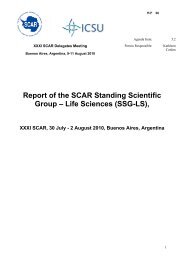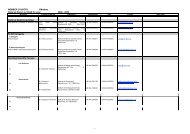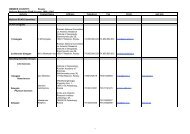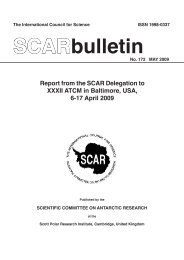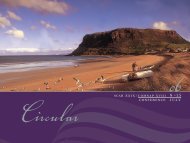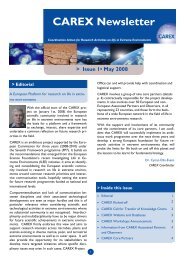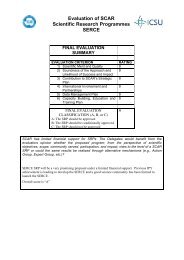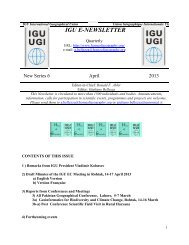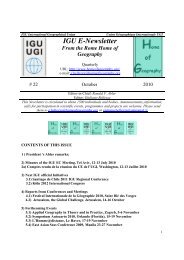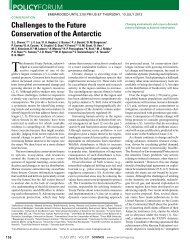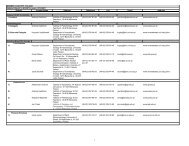BipAG Briefing Note - Scientific Committee on Antarctic Research
BipAG Briefing Note - Scientific Committee on Antarctic Research
BipAG Briefing Note - Scientific Committee on Antarctic Research
You also want an ePaper? Increase the reach of your titles
YUMPU automatically turns print PDFs into web optimized ePapers that Google loves.
BRIEFING NOTE FOR BIPAG (19/2/2008)<br />
<str<strong>on</strong>g>BipAG</str<strong>on</strong>g> has two main terms of reference.<br />
ToR (1) is to advise the SCAR and IASC Executive <str<strong>on</strong>g>Committee</str<strong>on</strong>g>s <strong>on</strong> the development<br />
of instruments such as workshops, programs and networks to address bipolar issues<br />
(i.e. the first priority is to see how and where we could work, more closely together).<br />
Under this ToR, SCAR and IASC have comm<strong>on</strong> interests in several fields of polar<br />
science whose generic attributes transcend geography. Clearly these include glaciology,<br />
ice cores, permafrost, oceanography, climate, paleoclimate, cold water biology, upper<br />
atmosphere processes and so <strong>on</strong>. What workshops could/should we be pursuing to<br />
advance the science in these areas.<br />
We already collaborate closely through workshops, in particular<br />
(i) High Latitude Climate Workshops - look under Reports <strong>on</strong><br />
http://www.scar.org/researchgroups/physicalscience/, and<br />
(ii) Ice Sheet Modelling (look under ISMASS Expert Group <strong>on</strong> the same page).<br />
The ice sheet modelling workshop described there takes place in July in St<br />
Petersburg and is linked to our ability to forecast changing sea levels.<br />
(iii) We have together with others submitted a grant proposal to ICSU for funds<br />
for a summer school <strong>on</strong> ice sheet modelling for 2009, as a follow up to (ii)<br />
above.<br />
There seems to be some enthusiasm for<br />
(iv) holding a joint workshop between SCAR's ACE programme (<strong>Antarctic</strong><br />
Climate Evoluti<strong>on</strong>) (already with a bipolar aspect through IPY project<br />
BIPOMAC), and IASC's APEX (Arctic Paleoclimate and its Extremes)<br />
programme. Do we take this forward? If so how?<br />
In glaciology, ice sheet modelling is an area of <strong>on</strong>going collaborati<strong>on</strong>. In additi<strong>on</strong>,<br />
(v) SCAR has a joint Memorandum of Understanding with WCRP regarding the<br />
co-sp<strong>on</strong>sorship of the Climate and Cryosphere programme (CliC); IASC is<br />
about to join that co-sp<strong>on</strong>sorship. This will help SCAR and IASC to provide<br />
some steering for CliC.<br />
(vi) SCAR and IASC have proposed a letter of agreement tying us to the new<br />
Internati<strong>on</strong>al Associati<strong>on</strong> for Cryospheric Sciences (IACS) of the IUGG; the<br />
issue will be decided by the April IACS Council. Where might that<br />
development lead?
(vii) SCAR and WCRP co-authored a plan for a bipolar cryospheric observing<br />
system (CryOS, which can be downloaded from<br />
http://www.eohandbook.com/igosp/cryosphere.htm. We need a<br />
recommendati<strong>on</strong> that IASC be asked to work with SCAR and WCRP to<br />
implement this system and m<strong>on</strong>itor its performance.<br />
(viii) SCAR is now a co-sp<strong>on</strong>sor of the Integrated Partnership for Ice Core<br />
Science (IPICS) (with PAGES); clearly, given that IPICS is working in both<br />
Greenland and the <strong>Antarctic</strong>, there is an opportunity for IASC to also cosp<strong>on</strong>sor<br />
IPICS;<br />
There may well be other opportunities for cross linkages in glaciology.<br />
In terms of the upper atmosphere<br />
(ix) SCAR has a Bipolar research programme <strong>on</strong> Interhemispheric C<strong>on</strong>jugacy<br />
Effects in Solar Terrestrial and Aer<strong>on</strong>omy <strong>Research</strong> (ICESTAR)? Should<br />
IASC arrange to join this in some way, and if so how?<br />
In terms of permafrost<br />
(x) SCAR has a Permafrost (PPE) Expert Group that is linked to the Internati<strong>on</strong>al<br />
Permafrost Associati<strong>on</strong> (IPA); can we build a link to IASC through the<br />
permafrost c<strong>on</strong>necti<strong>on</strong>?<br />
In terms of the oceans<br />
(xi) Is there potential for a link between IASC and SCAR in the oceans? (note that<br />
AOSB generally supports the suggested new <str<strong>on</strong>g>Scientific</str<strong>on</strong>g> Standing <str<strong>on</strong>g>Committee</str<strong>on</strong>g><br />
(SSC) structure of IASC and views itself as the SSC for the Marine System;<br />
after a transiti<strong>on</strong> phase of about 18 m<strong>on</strong>ths AOSB would become a part of<br />
IASC). SCAR already has an oceans group jointly sp<strong>on</strong>sored with SCOR. Is<br />
there potential for a SCAR/SCOR/IASC-AOSB polar oceans group - or some<br />
link (joint workshops) between the SCAR/SCOR group and IASC-AOSB?<br />
In terms of biology<br />
(xii) What potential links may exist in polar biology? SCAR has both terrestrial<br />
and marine biology programmes, which come together within EBA (Evoluti<strong>on</strong><br />
and Biodiversity in the <strong>Antarctic</strong>). How, if at all, might these link up with<br />
IASC's interests?
In terms of health and medicine<br />
(xiii) SCAR has a human biology and medicine group looking mainly at the<br />
health of scientists in extreme envir<strong>on</strong>ments. Are there possible links to<br />
IASC?<br />
In terms of observing systems<br />
(xiv) IASC is developing the Sustained Arctic Observing Network (SAON). In<br />
this, it is further ahead than SCAR, which is trying to develop something<br />
similar (Pan-<strong>Antarctic</strong> Observing System network - PAntOS), which is as yet<br />
in its infancy and can learn from SAON. Indeed, it was by copying the<br />
original AON model that we started PAntOS rolling.<br />
To get a yet more comprehensive view of what SCAR is doing that may be of interest to<br />
IASC, it may well prove useful to <str<strong>on</strong>g>BipAG</str<strong>on</strong>g> simply to browse the web pages of the three<br />
SCAR Standing <str<strong>on</strong>g>Scientific</str<strong>on</strong>g> Groups to see what projects exist that might be the basis for<br />
some links to IASC.<br />
Life Sciences: http://www.scar.org/researchgroups/lifescience/<br />
Physical Sciences: http://www.scar.org/researchgroups/physicalscience/<br />
Geosciences: http://www.scar.org/researchgroups/geoscience/<br />
In additi<strong>on</strong>, much of what SCAR is trying to achieve is described in the SCAR Strategic<br />
and Implementati<strong>on</strong> Plans at http://www.scar.org/about/introducti<strong>on</strong>/futureplans/. In<br />
c<strong>on</strong>trast, the science that IASC would like to achieve is described under the ICARP plans.<br />
The sec<strong>on</strong>d of <str<strong>on</strong>g>BipAG</str<strong>on</strong>g>'s Terms of Reference, <str<strong>on</strong>g>BipAG</str<strong>on</strong>g> (2) is to advise the SCAR and<br />
IASC Executive <str<strong>on</strong>g>Committee</str<strong>on</strong>g>s <strong>on</strong> the development of mechanisms to nurture the IPY<br />
2007/2008 legacy, with a special focus <strong>on</strong> the roles of IASC and SCAR.<br />
The background here is the IPY. During the IGY, ICSU realised it needed some kind of<br />
body to c<strong>on</strong>tinue the internati<strong>on</strong>al coordinati<strong>on</strong> that had been started so successfully in<br />
<strong>Antarctic</strong>a as part of the IGY, and it created SCAR to undertake that task - which we<br />
have been doing for 50 years. Had there not been a cold war at the time, SCAR might<br />
well have ended up as SCAAR (<str<strong>on</strong>g>Scientific</str<strong>on</strong>g> <str<strong>on</strong>g>Committee</str<strong>on</strong>g> for Arctic and <strong>Antarctic</strong> <strong>Research</strong>).<br />
As it was, coordinati<strong>on</strong> am<strong>on</strong>gst Arctic countries proved more difficult, so it was quite a<br />
while before IASC was formed. Now IASC is affiliated to ICSU, and SCAR is part of<br />
ICSU, and IASC and SCAR are binding themselves to IACS, which is also part of ICSU<br />
(IUGG), and have bound themselves to WCRP (which is co-sp<strong>on</strong>sored by ICSU, WMO<br />
and IOC of UNESCO). So, all 4 of ICSU's polar elements are now tied together. In<br />
additi<strong>on</strong>, ICSU is co-sp<strong>on</strong>sor of the IPY, and SCAR and IASC are part of the Steering<br />
<str<strong>on</strong>g>Committee</str<strong>on</strong>g> for the IPY. This is now, therefore, the right time to be thinking about how
polar science is going to be coordinated and managed as an internati<strong>on</strong>al scientific<br />
enterprise after the IPY. Do we need a new structure or structures? If so, what? Should<br />
there perhaps be a single umbrella polar organisati<strong>on</strong> under which SCAR and IASC<br />
c<strong>on</strong>tinue? Should that organisati<strong>on</strong> comprise a number of generic elements (cryosphere,<br />
oceans, biology, etc) rather than discrete regi<strong>on</strong>al bodies - in which case we would not<br />
need SCAR or IASC. Could the IPY-JC (Joint or Steering <str<strong>on</strong>g>Committee</str<strong>on</strong>g>) evolve into that<br />
umbrella body? Or do we carry <strong>on</strong> as we are, bound together by memoranda of<br />
understanding and letters of agreement.<br />
Joern Thiede has suggested that the polar sciences do not have a high enough profile at<br />
meetings like the ICSU General Assembly, because there is no polar body with a high<br />
enough profile to be there in its own right. The polar sciences are in effect all represented<br />
through other bodies (e.g. like IACS through IUGG). For that reas<strong>on</strong> he feels we need a<br />
Polar Science Uni<strong>on</strong>. However that might be difficult to get, given that it would<br />
inevitably take away parts of what other uni<strong>on</strong>s currently feel they 'own' (i.e. the polar<br />
dimensi<strong>on</strong>s of their own subject areas).<br />
Chris Rapley has made the point that the polar sciences also suffer from low<br />
representati<strong>on</strong> when it comes to the activities of ICSU's big IGBP programme and, in<br />
turn, within the Earth System Science Partnership (ESSP) that brings together IGBP,<br />
WCRP, IHDP and DIVERSITAS. SCAR and IASC seem, as it were, 'frozen out' of<br />
IGBP and ESSP. Whether or not that might be solved by a different structure remains to<br />
be seen. How does <str<strong>on</strong>g>BipAG</str<strong>on</strong>g> think we can solve it.<br />
The SCAR and IASC Executives recognise that we may in due course need a higher<br />
powered joint committee than a short lived Acti<strong>on</strong> Group to c<strong>on</strong>sider these weighty<br />
matters, but we have to start somewhere, and <str<strong>on</strong>g>BipAG</str<strong>on</strong>g> is it. Do we need a Standing<br />
<str<strong>on</strong>g>Committee</str<strong>on</strong>g>?<br />
Aside from c<strong>on</strong>siderati<strong>on</strong>s about structure, there are also c<strong>on</strong>siderati<strong>on</strong>s about other<br />
aspects of the legacy - how should we be exchanging and managing data and informati<strong>on</strong>,<br />
for instance. SCAR has its Joint <str<strong>on</strong>g>Committee</str<strong>on</strong>g> for <strong>Antarctic</strong> Data Management, which<br />
brings together the managers of the <strong>Antarctic</strong> Data Centres. Does IASC need something<br />
similar? Or should JCADM's remit be expanded to take <strong>on</strong> the Arctic? This is the time to<br />
think the unthinkable. We (<str<strong>on</strong>g>BipAG</str<strong>on</strong>g>) can get good advice by talking to other global data<br />
bodies, like IOC's IODE (Internati<strong>on</strong>al Ocean Data and Informati<strong>on</strong> Exchange<br />
Programme).<br />
How should we be developing the observing systems that we need to underpin the<br />
science and the forecasting of change? Do we need a separate SAON and PAntoS, or<br />
should they be combined? Should they be working to the same plan and the same<br />
standards? How should they c<strong>on</strong>nect to the global observing programmes like GOOS,<br />
GCOS, GTOS, the GEOSS and the new Group <strong>on</strong> Earth Observati<strong>on</strong>s (GEO)<br />
headquartered at WMO in Geneva? What is or should be the link to the operati<strong>on</strong>al<br />
agencies that will ultimately make and/or use the observati<strong>on</strong>s?
Then there is the questi<strong>on</strong> of nurturing the next generati<strong>on</strong> of polar researchers - how<br />
should that best be d<strong>on</strong>e by SCAR and IASC separately or together? What should our<br />
relati<strong>on</strong>ship be to the new Associati<strong>on</strong> of Polar early Career Scientists (APECS), a<br />
creature of the IPY? Currently we have agreed to co-sp<strong>on</strong>sor their <strong>on</strong>e-day meeting in St<br />
Petersburg. Some kind of joint sp<strong>on</strong>sorship is under c<strong>on</strong>siderati<strong>on</strong>.<br />
No doubt there are many other questi<strong>on</strong>s of building and maintaining a str<strong>on</strong>g IPY legacy<br />
- not least am<strong>on</strong>g them the issue of public engagement and outreach, which have not<br />
heretofore featured prominently in SCAR or IASC's portfolio (perhaps rightly, perhaps<br />
not).<br />
That in turn raises the questi<strong>on</strong> of the extent to which either organisati<strong>on</strong> should or could<br />
be liaising with or working with the Internati<strong>on</strong>al Glaciological Society.<br />
In additi<strong>on</strong> there is the questi<strong>on</strong> of to what extent we could or should be writing or<br />
stimulating the producti<strong>on</strong> of books or films <strong>on</strong> polar topics for the interested layman.<br />
There is political support for building the IPY legacy, and especially for building<br />
observing systems. It comes in the recent resoluti<strong>on</strong>s of both the Arctic Council and the<br />
<strong>Antarctic</strong> Treaty C<strong>on</strong>sultative Meeting (for the latter see Resoluti<strong>on</strong> E <strong>on</strong> page<br />
http://www.scar.org/treaty/).<br />
Finally there is the questi<strong>on</strong> of trust by the scientific community in our various<br />
organisati<strong>on</strong>s. SCAR has rebuilt a lot of trust following its major reorganisati<strong>on</strong> in 2000.<br />
IASC is just going through a very similar reorganisati<strong>on</strong>, and it may take a while to build<br />
trust to the same level. How do we build it quickly? Could the links to SCAR be helpful?<br />
Timing and First Task<br />
<str<strong>on</strong>g>BipAG</str<strong>on</strong>g> is created initially for 2 years to provide advice to IASC Council and the SCAR<br />
Delegates. The Delegates meet in Moscow <strong>on</strong> July 14-16, so a paper will be needed for<br />
that meeting, setting out <str<strong>on</strong>g>BipAG</str<strong>on</strong>g>'s initial ideas and plans. That paper will also go to the<br />
IASC Council meeting in the fall in 2008. It would be anticipated that the next and final<br />
paper would go to the SCAR Delegates and the IASC Council in 2010.<br />
It would be useful if the initial paper could be drafted before we all get to St Petersburg,<br />
so that at our <str<strong>on</strong>g>BipAG</str<strong>on</strong>g> meeting <strong>on</strong> the evening of July 6 we could finalise it ready for<br />
delivery to the Delegates <strong>on</strong> the 14th.



